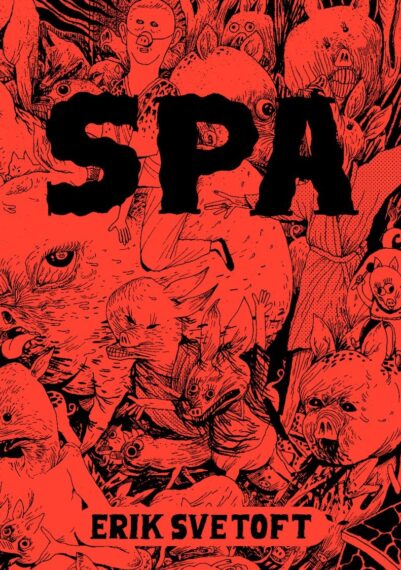 By ERIK SVETOFT (Fantagraphics Books; 2021/23)
By ERIK SVETOFT (Fantagraphics Books; 2021/23)
This graphic novel, the debut book from writer-illustrator Erik Svetoft, hails from Sweden, and I say this Fantagraphics published English translation is an absolute necessity. A quasi-satiric, surreal vision of transmutation and reality displacement, SPA has been compared with Lynch, Cronenberg and Junji Ito, but is in fact completely unique. Charles Burns seems the best comparison I can think of, with SPA sharing many similarities with Burns’ immortal BLACK HOLE.
The setting is a bathhouse in an exclusive hotel whose corporatized proprietors promise “space for relaxation and human interaction” via a series of specially tailored holistic treatments. We meet a number of the people who sign on to these treatments, as well as several of the employees, including the spa’s mustachioed director, who’s taken over the job from his father; a receptionist who’s constantly arguing on the phone with a never-seen someone; a patient who’s given a pig nose mask as part of a healing exercise and ends up wearing it wherever he goes; a mentally unstable, perpetually teary cook; and a pair of (very) wide-eyed repair people who don’t appear to know much of anything about their job.
This is all extremely fragmentary and episodic. There’s no story to speak of, with the driving element being a sense of overpowering weirdness that begins with some fly-ridden corpses glimpsed in various areas of the spa, and a spot of mold that expands exponentially. Further oddities include a trio of distinctly cartoony personages that emerge from a painting, a band of mutant pigs unleashed by the pig nose mask wearer, a man who literally walks into walls and random people metamorphosing into horrific human-animal hybrids. I’ll confess I’m not precisely sure what Erik Svetoft is trying to say about the wellness industry, outside the fact that it’s poorly run and inherently corrupt (things I already knew).
Svetoft’s black and white drawings are what truly make SPA the standout publication it is. As with the best manga artists, Svetoft has a gift for packing his ideas into sparsely worded panels that don’t require a lot of study to fully register. His characters are certainly distinctive, bearing large heads, tiny noses and dimpled mouths, and his visual storytelling, which tends to utilize facial close-ups in place of action, even more so. He also favors swirling, blood-spattered backgrounds, which given the book’s surreal-horrific gist are an entirely appropriate addition.


